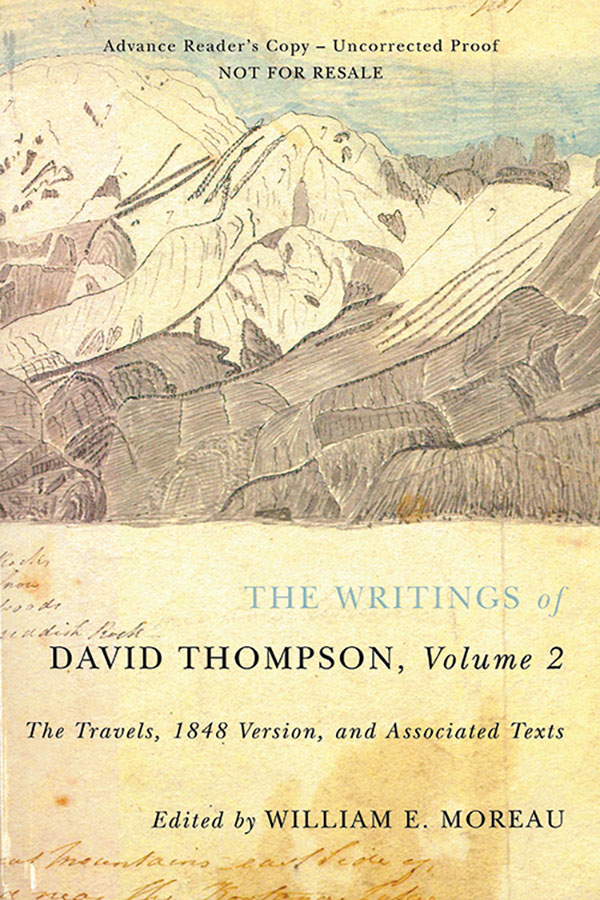by Graham A. MacDonald
Parksville, British Columbia
|
The Writings of David Thompson, Volume 2: The Travels, ‘1848’ Version, and Associated Texts. Edited with an Introduction by William E. Moreau. Toronto: McGill-Queen’s University Press and The Champlain Society, 2015, 384 pages. ISBN 978-0-7735-4551-9, $44.95 (paperback)
 Fur trader and explorer David Thompson (1770-1857) has done well by the Champlain Society since 1916, when geologist J.B. Tyrrell published David Thompson’s Narrative of his explorations in western America. 1784-1812 under Society sponsorship. This was followed by a second version in 1962, edited by Richard Glover, incorporating a missing chapter located in the Ontario Archives in 1957 by Victor Hopwood. Both of these versions of the Narrative were organized in two distinct sections, the first dealing with the period 1784 to 1806 and the second from 1807 to 1812, after which Thompson returned to Eastern Canada and retired from the fur trade. With the exception of the new chapter, these editions had been worked up from original draft Thompson manuscripts and papers which Tyrrell had purchased in 1895 from Charles Lindsey, who had earlier obtained them from Thompson’s son, Joshua.
Fur trader and explorer David Thompson (1770-1857) has done well by the Champlain Society since 1916, when geologist J.B. Tyrrell published David Thompson’s Narrative of his explorations in western America. 1784-1812 under Society sponsorship. This was followed by a second version in 1962, edited by Richard Glover, incorporating a missing chapter located in the Ontario Archives in 1957 by Victor Hopwood. Both of these versions of the Narrative were organized in two distinct sections, the first dealing with the period 1784 to 1806 and the second from 1807 to 1812, after which Thompson returned to Eastern Canada and retired from the fur trade. With the exception of the new chapter, these editions had been worked up from original draft Thompson manuscripts and papers which Tyrrell had purchased in 1895 from Charles Lindsey, who had earlier obtained them from Thompson’s son, Joshua.
The book under review is the second of three new volumes sponsored by the Champlain Society on the unpublished writings of Thompson. The first appeared in 2009 and dealt with the ‘1850 version’ of Thompson’s Travels (reviewed in Manitoba History, No. 63, Spring 2010). The third, still to appear, will bring together unpublished miscellaneous writings. These new editions of the Narrative have been prepared from various extant drafts and supplementary notebook materials in the Ontario Archives and the Thomas Fisher Library of the University of Toronto, in order to give greater coherence to the 1916 version and to determine how it took shape. William E. Moreau, the disciplined editor of this new offering, once again keeps the many balls of the fragmentary Thompson manuscripts in the air with sure hands. The viewpoint brought to bear remains, as in 2009, that of ‘genetic criticism,’ the practice of literary historians who wish to inspect well known works in all of their previous iterations and with a view to their contexts (p. xxv).
Mr. Moreau’s main enterprise in these new volumes has been to sort out what he takes to be the proper sequence and content of Thompson’s travel narrative. The ‘1850’ version (Thompson’s last effort to finish the work) was left incomplete owing to illness, but he had been drawing on previous completed drafts up to the point where his pen fell silent. The editor concludes that “the 1848 Travels is the most complete and self-contained version of Thompson’s Narrative, with a clear conclusion that coincides with the end of his active fur trade career” (pp. xxii-xxiii). It is clear from the analysis that Tyrrell had drawn upon both versions for his edition, particularly for Part II which took the story up to 1812, as did the 1848 manuscript, ; whereas, the 1850 version ended in 1807. The result is that Mr. Moreau gives us an edition organized in four parts rather than two, as follows: 1) The Western Interior; 2) The Natives of North America; 3) Across the Divide, 1807-1811; 4) To the Pacific and Down to Montreal, 1811-1812. The new text is richly annotated with reference to Thompson’s Notebooks and to the scholarly literature as it has developed since Hopwood’s abbreviated edition of 1971. Several appendices are included of previously unpublished material, which amplify the main text.
Mr. Moreau has other questions to put, however. What kind of literary ‘strategy’ had Thompson adopted late in life, when these events were so far in the past? From his Introduction we learn much about Thompson’s reading habits after his return to Montreal. It was known before that Thompson attempted to follow, from his earliest days on Hudson Bay, literary developments in England and Europe. Just how closely he followed advances in geology, natural history and anthropology is made clearer here. Such interests blended in well with literary ambition and the commercial prospects of the well-told tale. Thus, there seems to have been no reluctance to ‘embellish’ the story, either from memory or with the assistance of other sources. The genre and requirements of ‘Travel’ literature were much on Thompson’s mind (as they had been on the minds of so many in the fur trade) and he made good use of the well-stocked Public Library in Montreal (p. xxxiv). Clearly, the dry as dust scientific entries of his notebooks required amplification for a general reading public. He had a “conscious and evolving narrative strategy” one, which, says Moreau “altered his story, not with the craft of a deceiver, but with that of an artist” (p. xxxvi).
We thank Clara Bachmann for assistance in preparing the online version of this article.
We thank S. Goldsborough for assistance in preparing the online version of this article.
Page revised: 26 November 2020